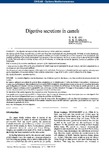Digestive secretions in camels
| dc.contributor.author | Maloiy, GMO | |
| dc.contributor.author | Kay, RNB | |
| dc.date.accessioned | 2013-07-05T11:47:56Z | |
| dc.date.available | 2013-07-05T11:47:56Z | |
| dc.date.issued | 1989 | |
| dc.identifier.citation | OLE, PROFMALOIYGEOFFREYM. 1989. KAY, R.N.B. and MALOIY, G.M.O.(1989) Digestive secretions in camels. In: Seminaire sur la Digestion, la Nutrition at l'alimantation du Dromadaire, ed. J.L. Tisserand, pp. 83-87, Options Mediterranees, Serie A, No. 2.. Proceedings of International Union of Physiological Sciences 17, 335.. : EAMJ | en |
| dc.identifier.uri | http://erepository.uonbi.ac.ke:8080/xmlui/handle/123456789/45824 | |
| dc.description.abstract | The digestive secretions of both old world and new world camels are considered The salivary glands closely resemble those of cattle and sheep both morphologically andphysiologically. Evidently, as in the Ruminantia, they provide almost all of the fluid and alkali needed to maintain favourable conditions for microbial digestion in the forestomach. The glandular epithelium of the camees forestomach does not seem to have an important role in this respect except in that its free permeability to volatile fatty acids allows exchange of fatty acids for bicarbonate, as occurs also across the squamous keratinised epithelium of the Ruminantia. Little is known of t?te secretions and digestive processes of the hindstomach and iktestines. A large part (up to about 90%) of the urea formed in the camees body may be hydrolysed in the gut. This provides and endogenous source of nitrogen for microbial protein synthesis. The forestomach contains about a quarter of the water in the whole body It serves as a substantial and dynamic reservoir, releasing water during dehydration and accommodating it when a thirsty animal takes a huge drink to allow gradual rehydration of the tissues. | en |
| dc.language.iso | en | en |
| dc.publisher | University of Nairobi | en |
| dc.title | Digestive secretions in camels | en |
| dc.type | Article | en |

